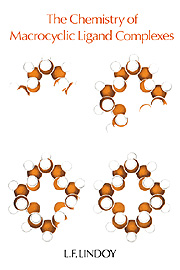Book contents
- Frontmatter
- Contents
- Preface
- 1 What is different about macrocyclic ligand complexes?
- 2 Synthetic procedures
- 3 Macrocyclic systems – some further categories
- 4 The metal-ion chemistry of polyether and related macrocyclic systems
- 5 Host-guest chemistry: macrocyclic hosts and non-metallic guests
- 6 Thermodynamic considerations
- 7 Kinetic and mechanistic considerations
- 8 Redox properties
- 9 The natural macrocycles
- References
- Index
3 - Macrocyclic systems – some further categories
Published online by Cambridge University Press: 08 October 2009
- Frontmatter
- Contents
- Preface
- 1 What is different about macrocyclic ligand complexes?
- 2 Synthetic procedures
- 3 Macrocyclic systems – some further categories
- 4 The metal-ion chemistry of polyether and related macrocyclic systems
- 5 Host-guest chemistry: macrocyclic hosts and non-metallic guests
- 6 Thermodynamic considerations
- 7 Kinetic and mechanistic considerations
- 8 Redox properties
- 9 The natural macrocycles
- References
- Index
Summary
Preliminary remarks
There has been a steady tendency in the field of macrocyclic chemistry to undertake the synthesis of new ring systems which exhibit ever-increasing structural diversity. Such investigations have resulted in several new categories of cyclic systems being developed. In this chapter, a number of such ‘derivative’ macrocyclic systems are discussed. For each category, a range of representative complexes is described, together with a discussion of selected properties for each ring system. Thus, each chapter section gives a ‘cameo’ view of these ligand categories. Collectively, the discussions also provide a perspective of some of the important advances in the continuing development of new macrocyclic systems.
Macrocycles with pendant functional groups
There has been considerable activity concerned with the synthesis of cyclic systems related to the monocyclic rings discussed in Chapters 1 and 2 but which also contain appended side chains incorporating additional donor functions. Such products have been obtained both from structural modification of selected simple rings as well as via synthetic procedures designed to produce the required macrocycle directly from non-cyclic precursors. Products of this type are structurally related to both the simple macrocyclic as well as the open-chain ligand categories. For example, many of the complexes exhibit the kinetic inertness which is typical of cyclic systems while still showing some of the coordination flexibility frequently associated with open-chain ligands.
Many ligands of this category offer the prospect of inducing axial metal-ion coordination even for those cases where the pendant arms incorporate weak donor functions.
- Type
- Chapter
- Information
- The Chemistry of Macrocyclic Ligand Complexes , pp. 51 - 89Publisher: Cambridge University PressPrint publication year: 1989



